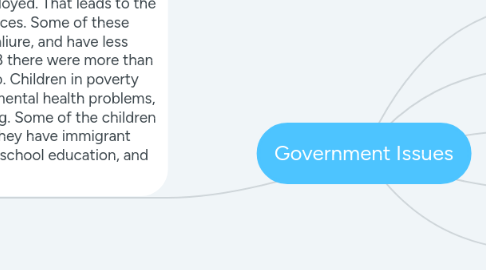
1. Child poverty is when a child is living in a low-income household or their parents are unemployed. That leads to the child having limited or no basic resources. Some of these children are more likley to feel like a faliure, and have less hope about their future. Sadly, in 2018 there were more than 125,000 children in poverty in Toronto. Children in poverty also have a higher risk of developing mental health problems, being in debt, and having poor housing. Some of the children with a higher risk of poverty is when they have immigrant parents, parents with less than a high school education, and parents with a mental dissability.
1.1. What are some issues that cause child poverty?
1.1.1. The main issue is when children are born into poor family's. Also, another cause is low wages, the tax system, and the prices of child care.
1.2. How do Canadian citizens help with child poverty?
1.2.1. Canadian citizens help by donating to local food banks. At a lot of Toronto schools they have donations neer the holidays. A lot of people give homeless people/ people in poverty spare change. Even though it is not much it is usually enough for a meal. There are also lots of organizations like the child poverty action network.
1.3. What wards in Toronto are affected mostly by child povrty?
1.3.1. The Eglinton-Lawrence ward has a very high child poverty rate of 52.6% of children in poverty.
1.4. What are some challenges that children in child poverty face?
1.4.1. Some chalenges are going without food because food banks don't have enough food to feed everyone. Also some families might not have a food bank neer where they live. Another challenge is healthcare. A lot of healthy food is expensive and that means children in poverty can't afford it. This leads to children in poverty 80% more likly to have diabeties and 60% more likely to have high blood presure.
1.5. How is the government helping with child poverty?
1.5.1. The government gives free public transit to children 12 and under. This helps because some children don't have a way to get to school for free. Families in poverty also get lower prices for child care.
1.6. What other programs could the government make to help with child poverty?
1.6.1. They could create healthier food programs. There is some healthy food programs but they have very limited supplies. My idea is that they could create meal kits at low prices so children in poverty can have a lower chance of getting diabetes and other diseases.
1.7. What do you think about child poverty and what are some other perspectives on it?
1.7.1. I think that it is very sad because even though these children are born into poor families it doesn't mean they have to have less opportunities. Some other people might think that it's their parents responsibility to take care of their children, but you never know what happened to put them in poverty.
1.8. What happens to kids that are in child poverty?
1.8.1. Some of them are more likely to feel like they are not going to have a future because they are poor. They also have a higher chance of developing mental health problems.
1.9. Has child poverty gotten worse or better over the years?
1.9.1. Between 1980 and 2015 14% of canadian children were in poverty in 2017 9.5% of canadian children were in poverty. This means that child poverty has gotten better, but there are still lots of children in poverty.
1.10. What could be done to decrease child poverty?
1.10.1. Higher pay for minimum wage workers so that parents can have enough money to take care of their kids.
1.11. What have charities and non-profit orginizations done to help with child poverty?
1.11.1. Food banks help provide food for families and children in poverty.
1.12. What cultures are more at risk for child poverty?
1.12.1. Sadly 84% of indigenous peoples are in poverty. Some other races that are in poverty are West Asian, Arab, Black, Latin American, Korean, and chinese.

